
Nexperia introduces the best-in-class portfolio of I²C GPIO expanders
Nexperia I2C General-Purpose I/O (GPIO)
Nexperia's Interface family comprising of I²C GPIO expanders and translators improves system functionality and reliability by providing technologies that offer lower power consumption to ensure high-performance signal transfer.
Provide 16 bits of General Purpose Input/Output (GPIO) expansion for I²C-bus/SMBus applications. It is designed for a wide voltage range of 1.65 V to 5.5 V with interrupts and default pull-up resistors on GPIOs. Nexperia GPIO expanders provide an elegant solution when additional IOs are needed while keeping the interconnections to a minimum, for example, in ACPI power switches, sensors, push buttons, LEDs, and fan control.
The NCA9555 contains a set of 8 bit input, output, configuration and polarity inversion registers. At power up all IOs default to inputs. Each IO can be configured as either input or output by changing the corresponding bit in the configuration register. The data for each input or output is stored in the corresponding input or output register. The polarity inversion register can be programmed to invert the polarity of the input register.

Features
- Wide supply voltage range
- Low propagation delay
- Low power consumption of 2.5 µA maximum
- Overvoltage tolerant options
- Specified from -40 °C to +85 °C and -40 °C to +125 °C
Applications
- Servers, routers and personal computing
- TV and hardware control monitors
- Gaming consoles and drones
- Battery powered applications
- Automotive applications (ADAS, VCU, DCU and BCM)Surveillance cameras
- Telecomm equipment
Upgrade your system and keep control of power consumption with I2C GPIO expanders
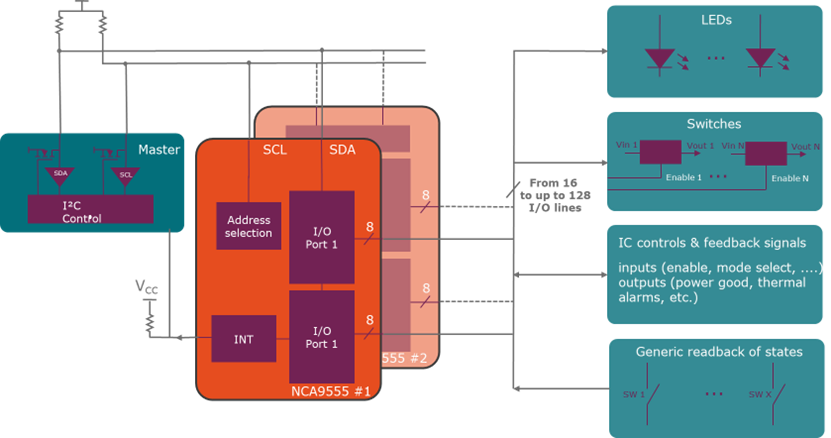
Product family
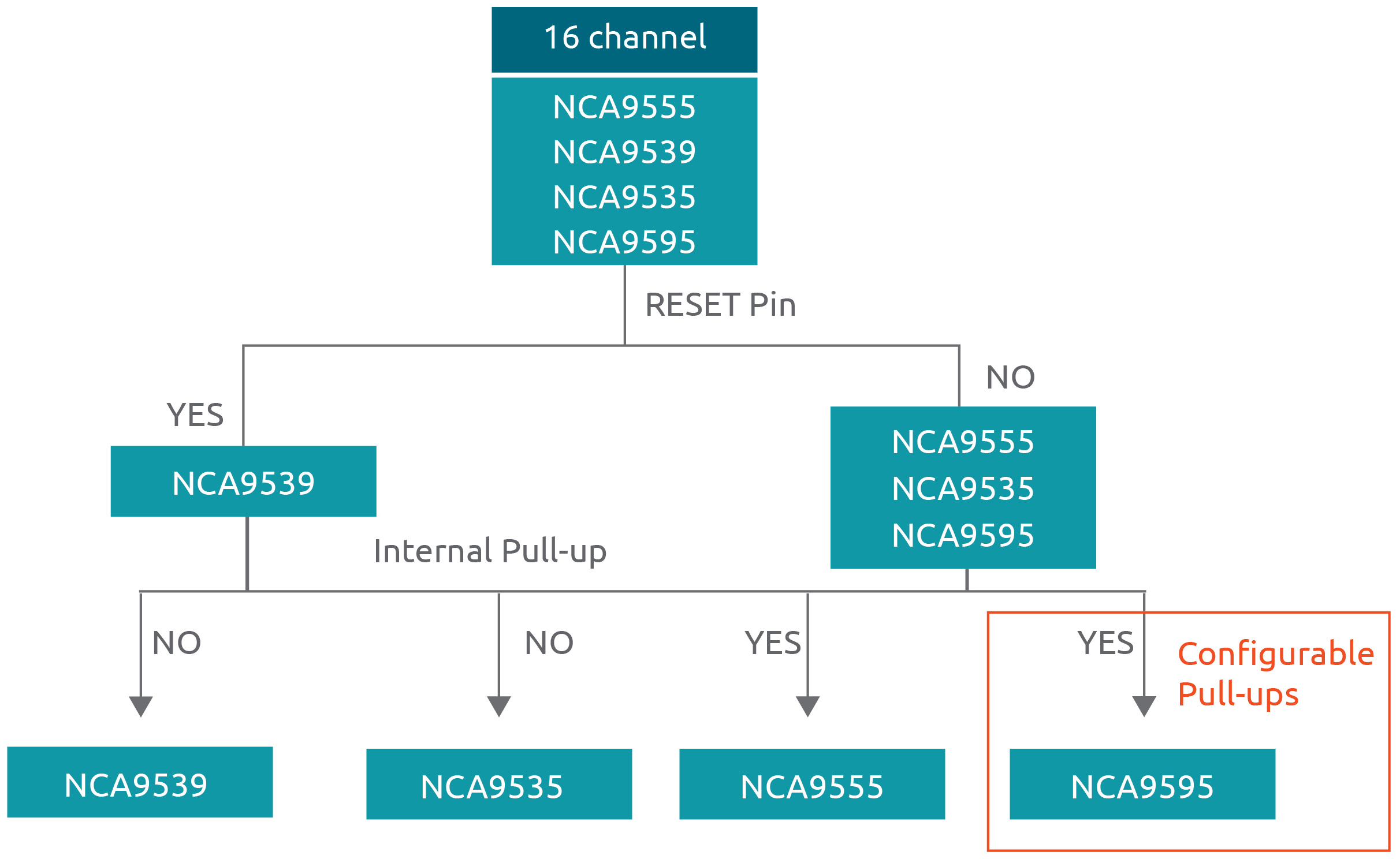
Products
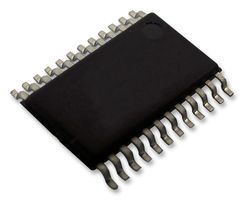
NCA9555PW
The NCA9555 has an open-drain interrupt output which is activated when any one of the GPIO changes from its corresponding input port register state. The power on reset sets the registers to default values and initializes the device state machine. The NCA9555 has three address pins A0, A1 and A2 which can be used to configure the I²C bus slave address of the device. It allows up-to eight devices to share the same I²C-bus/SMBus.
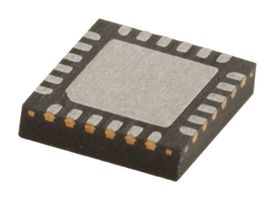
NCA9555BY
The NCA9555 has an open-drain interrupt output which is activated when any one of the GPIO changes from its corresponding input port register state. The power on reset sets the registers to default values and initializes the device state machine. The NCA9555 has three address pins A0, A1 and A2 which can be used to configure the I²C bus slave address of the device. It allows up-to eight devices to share the same I²C-bus/SMBus.
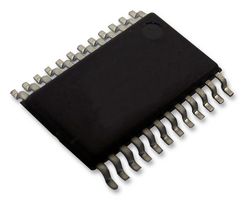
NCA9539PW
The NCA9539 has an open-drain interrupt output which is activated when any one of the GPIO changes from its corresponding input port register state. INT can be connected to the interrupt input of a microcontroller. By sending an interrupt signal on this line, the remote I/O can inform the microcontroller if there is incoming data on its ports without having to communicate via the I²C-bus. Thus, NCA9539 can remain a simple slave. The power on reset sets the registers to default values and initializes the device state machine. The RESET pin can be used to achieve same reset functionality without power down/up cycling by keeping active low. The state machine and the registers are in their default state until the RESET input is once again HIGH. This input requires pull up to VCC. The NCA9539 has two address pins A0 and A1 which can be used to configure the I²C bus slave address of the device. It allows up-to four devices to share the same I²C-bus/SMBus.

NCA9539PW-Q100
The NCA9539 has an open-drain interrupt output which is activated when any one of the GPIO changes from its corresponding input port register state. INT can be connected to the interrupt input of a microcontroller. By sending an interrupt signal on this line, the remote I/O can inform the microcontroller if there is incoming data on its ports without having to communicate via the I²C-bus. Thus, NCA9539 can remain a simple slave. The power on reset sets the registers to default values and initializes the device state machine. The RESET pin can be used to achieve same reset functionality without power down/up cycling by keeping active low. The state machine and the registers are in their default state until the RESET input is once again HIGH. This input requires pull up to VCC. The NCA9539 has two address pins A0 and A1 which can be used to configure the I²C bus slave address of the device. It allows up-to four devices to share the same I²C-bus/SMBus.

NCA9535PW
The NCA9535 has an open-drain interrupt output which is activated when any one of the GPIO changes from its corresponding input port register state. The power on reset sets the registers to default values and initializes the device state machine. The NCA9535 has three address pins A0, A1 and A2 which can be used to configure the I²C bus slave address of the device. It allows up-to eight devices to share the same I²C-bus/SMBus.

NCA9535PW-Q100
The NCA9535 has an open-drain interrupt output which is activated when any one of the GPIO changes from its corresponding input port register state. The power on reset sets the registers to default values and initializes the device state machine. The NCA9535 has three address pins A0, A1 and A2 which can be used to configure the I²C bus slave address of the device. It allows up-to eight devices to share the same I²C-bus/SMBus.

NCA9555BY-Q100
The NCA9555 has an open-drain interrupt output which is activated when any one of the GPIO changes from its corresponding input port register state. The power on reset sets the registers to default values and initializes the device state machine. The NCA9555 has three address pins A0, A1 and A2 which can be used to configure the I²C bus slave address of the device. It allows up-to eight devices to share the same I²C-bus/SMBus.

NCA9555PW-Q100
The NCA9555 has an open-drain interrupt output which is activated when any one of the GPIO changes from its corresponding input port register state. The power on reset sets the registers to default values and initializes the device state machine. The NCA9555 has three address pins A0, A1 and A2 which can be used to configure the I²C bus slave address of the device. It allows up-to eight devices to share the same I²C-bus/SMBus.

NCA9595PW
The NCA9595 has an open-drain interrupt output which is activated when any one of the GPIO changes from its corresponding input port register state. The power on reset sets the registers to default values and initializes the device state machine. The NCA9595 has three address pins A0, A1 and A2 which can be used to configure the I²C bus slave address of the device. It allows up-to eight devices to share the same I²C-bus/SMBus.

NCA9595PW-Q100
The NCA9595 has an open-drain interrupt output which is activated when any one of the GPIO changes from its corresponding input port register state. The power on reset sets the registers to default values and initializes the device state machine. The NCA9595 has three address pins A0, A1 and A2 which can be used to configure the I²C bus slave address of the device. It allows up-to eight devices to share the same I²C-bus/SMBus.